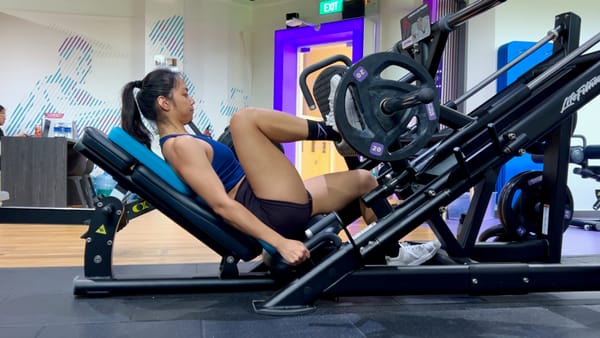How to Tone Your Body (And What It Actually Means)
Learn how to tone your body the right way. (Yes, there is a wrong way!) We cover common physique-sabotaging mistakes and misconceptions to avoid.

Interested in learning how to tone your body? Then, 2 things are likely true.
One, your ideal physique looks closer to this:
… instead of this:
And two, you're convinced that there's a particular ✨ way to strength train (e.g., “gentle” movements and/or light weights) that’ll help you achieve the aesthetics of the first GIF while keeping a wide berth from the second*.
*This article does not insinuate that the woman in the second GIF looks "bad" in any way. Aesthetic preferences are subjective — and this article was written specifically for readers who'd prefer to carry less muscle mass.
There's no nice way of saying this, but you're wrong. To understand why, know this:
You cannot tone a muscle
That’s because muscle fibers can only do 2 things: grow (i.e., get bigger) when sufficiently stimulated and atrophy (i.e., get smaller) during prolonged periods of inactivity.
There’s no such thing as toning a muscle.
What it really means to tone your body
Here's what you truly mean when you say you want to tone your body.
You want to:
How to tone your body
So, when it comes to toning your body, there are 3 things you need to do.
#1: Strength train (with progressive overload)
Want to build muscle?
Then you must do resistance training — an encompassing term for any exercise requiring your muscles to overcome some sort of oppositional force.
While there are many types of resistance training (e.g., plyometrics, yoga, and Pilates), strength or weight training is arguably the most effective at helping you increase muscle mass.
And, please, put those 1 kg dumbbells away.
Contrary to popular belief, lifting lighter weights for more reps will not give you "smaller, tighter, supermodel-esque" muscles. As mentioned earlier, when stimulated, your muscles only do 1 thing: grow.
If you're pushing yourself hard enough (training close to failure), research shows that you'd see similar muscle growth regardless of whether you’re using:
- Lighter weights at higher rep counts or
- Heavier weights at lower rep counts
If you ask me, since the resulting hypertrophy is comparable, I'd much prefer to stick with heavier weights at lower rep counts. I mean … it makes for a shorter workout 🤷♀️.
Make sure you implement progressive overload (i.e., increase your weight used and/or reps lifted) over time so your muscles have a reason to continue growing.
#2: Eat enough calories with sufficient protein
Uh, wait. Let’s go back to the 2 GIFs in the introduction for a minute.
“You mean the woman in GIF #1 could be training in a similar way to the one in GIF #2?”
Sounds unbelievable, but it’s probably true.
The main difference between them? The amount of muscle mass they have — and that ultimately comes down to their calorie (and protein) intake*.
*And, let's be honest, maybe a little more in the form of supplements and performance-enhancing drugs.
See, your body cannot build muscle mass from nothing.
Building muscle takes a lot of energy. That means your body needs loads and loads of calories for it. In fact, a 2022 meta-analysis suggests that eating in a calorie surplus (i.e., calories consumed > calories burned) is necessary for optimal muscle growth.
Meaning?
The woman in GIF #2 spent years training hard in a calorie surplus to pack on that amount of muscle mass.
The more you want your muscle to grow, the more energy you need to keep it growing.
And no, it most definitely doesn’t happen “by accident”. For anyone who has tried gaining muscle mass, you’ll know how intentional and deliberate you have to be.
Beyond that, she’ll have also eaten a ton of protein consistently. Protein, or, more accurately, amino acids, serve as the building blocks of muscles, after all.
So, unsurprisingly, research shows that the more protein you eat, the more muscle mass you’ll build — up to a point.
According to a 2018 meta-analysis investigating the effect of protein intake on muscle growth, you’re unlikely to see more hypertrophy beyond 1.6 g of protein per kg of body weight. For reference, if you weigh 60 kg, this will translate to an optimal daily protein intake of 96 grams.
OK, so what does all that mean to you as someone interested in learning how to tone your body?
Here’s a general guideline. If your BF%:
And no matter your BF%, don’t forget to eat enough protein!
#3: Get proper rest and recovery
When it comes to how to tone your body, recovering well is just as important as training hard and eating well.
That’s because when you don’t take time for proper rest and recovery, you put yourself at a higher risk of overtraining, which brings about a slew of nasty issues, including:
- Increased risk of injuries (bye-bye, gym)
- Decreased performance
- Loss of motivation
- Terrible mood swings
So, even as you work hard to tone your body, make time for rest days.
The American College of Sports Medicine and European College of Sport Science recommends at least 1 rest day weekly to prevent overtraining. But, of course, you may wish to take more rest days depending on your preferred training schedule and unique needs.
FAQs
Strength train. Eat enough calories and protein (depending on your BF%). And recover well.
Is that truly all it takes to tone your body? What about cardio? And what if you'd like only to tone specific parts of your body, such as your arms, belly, and thighs?
This section is dedicated to answering any remaining questions on how to tone your body.
#1: Should I do cardio?
Let’s be clear.
You don’t have to do cardio to tone your body if you don’t want to.
Yes, cardio will increase your daily energy expenditure (i.e., calories burned), which could boost your chances of achieving a calorie deficit necessary for lowering your BF%.
But the truth is that there are many other ways you could nudge your calorie balance in the right direction without feeling all miserable on the treadmill, elliptical, or Stairmaster.
Examples include:
That said, this doesn't mean you should skip cardio altogether. It's essential for your heart health! Most healthy adults should get at least 150 minutes of moderate aerobic activity or 75 minutes of vigorous activity weekly.
(Good news: lawn mowing counts as moderate activity, while heavy yard work counts toward vigorous activity.)
#2: Should I shorten my rest periods?
Aiming for a "two birds with one stone" scenario (cardio + strength training in a session)?
Yeah, don’t.
Remember that muscle growth is the goal you're trying to achieve with strength training in this whole how-to-tone-your-body article.
And, as it turns out, cutting your rest periods too short ends up hurting your lifting performance, which, in turn, negatively impacts your muscle growth!
Just so you know, here’s how long you should rest between sets to maximize hypertrophy:
- Single-joint exercises (e.g., bicep curls and leg extensions): 2 minutes
- Heavy compound movements (e.g., deadlifts and squats): 3 minutes
Of course, this is just a guideline. If you need more rest (and can afford a slightly longer workout), go for it!
If you’re pressed for time, you’d have to either shorten your rest time (at the expense of performance) or modify your workout to focus on fewer exercises.
#3: How to tone up the stomach? (Or [insert your stubborn fat area]?)
Sorry for bursting your bubble — but no matter what many YouTube videos claim, you cannot selectively tone (or lose fat from) certain body regions.
Your body draws energy from the body as a whole, not just from the cells in the area you’re working.
This means you won’t lose:
- Arm fat by simply doing arm exercises
- Belly fat by simply doing abs exercises
- Thigh fat by simply doing leg exercises
There’s no magic formula, proprietary workout, or top-secret techniques to tone selectively.
This should be a relief, isn’t it?
If you wish to tone a specific part of your body, you’ll have to pack on some muscle mass and then lose fat overall — which is exactly what you’ve learned to do in this how to tone your body article.
#4: What if I accidentally put on too much muscle?
Ah-ha! That question is a tell-tale sign you haven’t been paying attention (caught you!)
As mentioned earlier, muscle-building takes time. Lots of it. Even if you do everything right with your training, nutrition, and recovery, research suggests that you’d only see a 3% increase in muscle size monthly.
Worse, your muscle growth rate tends to slow as you gain experience and get closer to your genetic potential.
Most unenhanced experienced lifters (we’re talking 5 to 10 years of consistent, proper training and nutrition) would be ecstatic to see even a 1% increase in their muscle size monthly.
So, once again, you truly cannot “accidentally put on too much muscle”.
Muscle-building is almost always an intentional choice — and you’ll find the process to be a slow but rewarding one.
“Tone your body” the right way
There are no shortcuts or secret formulas to getting a toned body.
The key ingredients are always the same: strength training, nutrition, and rest. You need to focus on being consistent with them to see results.
And while it's all pretty simple in theory, the tricky part is finding a sustainable and enjoyable approach for yourself. That's what will take you time and effort to figure out.
Our advice? Be patient, experiment often, and learn from experience.





